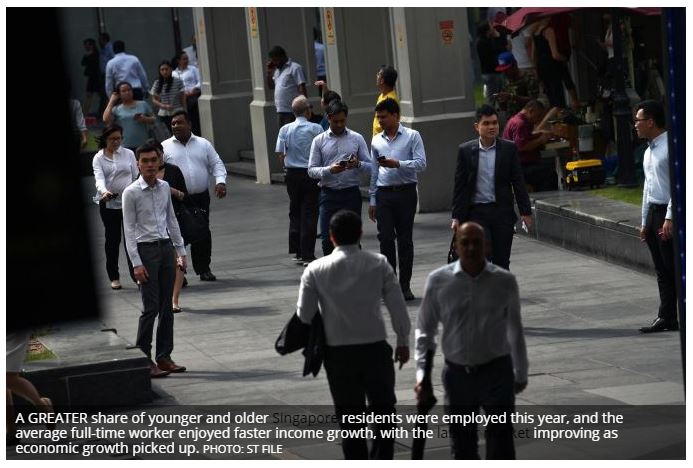Singapore employment rates, income growth up; PMETs take longer to find work, more contract jobs
A GREATER share of younger and older Singapore residents were employed this year, and the average full-time worker enjoyed faster income growth, with the labour market improving as economic growth picked up.
The unemployment rates for resident workers, both professionals, managers, executives and technicians (PMETs), as well as for non-PMETs, also dipped slightly as of June this year, compared with June last year.
The positive labour market outcomes this year were in line with good economic growth, said the Manpower Ministry (MOM) on Thursday. Singapore‘s economy is expected to grow by 3.0 to 3.5 per cent this year, at the upper end of an earlier forecast range of 2.5-3.5 per cent.
The MOM released a report based on the ministry’s Comprehensive Labour Force Survey conducted in the middle of this year of Singaporeans and permanent residents.
The employment rate for residents aged 15 to 24 rose to 34.5 per cent this year, up from 34.1 per cent last year, as more young people took on paid internships or vacation jobs.
The rate for those aged between 25 to 64 years old fell from 80.7 per cent to 80.3 per cent this year. MOM said the dip stemmed from more women in their 30s leaving the workforce to care for their families.
The rate for those aged 65 and over rose to 26.8 per cent, up from 25.8 per cent.
“Efforts to improve the employability of older workers encouraged more to stay on, and those previously outside the labour force to return to employment,” said the MOM.
The unemployment rate for PMETs was 2.9 per cent in June, compared with 3 per cent a year earlier. For non-PMETs, the rate was 4 per cent, down from 4.5 per cent.
PMETs now make up 57 per cent of the resident workforce.
However, more unemployed PMETs in their 30s and those aged 50 and up took a longer time to find work. This raised the long-term unemployment rate for PMETs to 0.8 per cent this year, up from 0.7 per cent last year.
This rate measures the proportion of workers who are jobless and looking for work for at least 25 weeks.
Also, a larger share of workers were on contract jobs. The share of workers in permanent jobs went down for the second consecutive year to 89 per cent this year, from 90 per cent last year.
MOM said this is because ongoing economic restructuring prompted companies to adopt a more near-term outlook, with much of the increase in contract employees seen among those on one-year contracts.
Nonetheless, workers saw their incomes growing faster in the last five years than in the preceding five-year period.
The real median gross monthly income of residents in full-time jobs grew by an average of 3.5 per cent per year from 2013 to 2018, taking preliminary inflation figures into account for this year. It grew by an average of 1.9 per cent per year from 2008 to 2013.
The median income was S$4,437 this year, including employer contributions to the Central Provident Fund, up from S$4,232 last year.
Lower-wage workers had their gross monthly incomes rise at a faster pace than at the median. Over the past five years, income at the 20th percentile for residents in full-time jobs rose by an average of 4.2 per cent per year, to S$2,340 in 2018.
MOM said in a statement that Singapore faces the structural challenges of an ageing population and slower population growth, which are expected to cause the supply of resident workers to moderate.
It called on businesses to invest in their workers.
“The MOM and Workforce Singapore will continue to work closely with unions, companies and jobseekers to address jobs-skills mismatches, match Singaporeans to good jobs and careers, and enable older Singaporeans who are able and willing to continue working to do so,” said MOM.
THE STRAITS TIMES


 English
English




